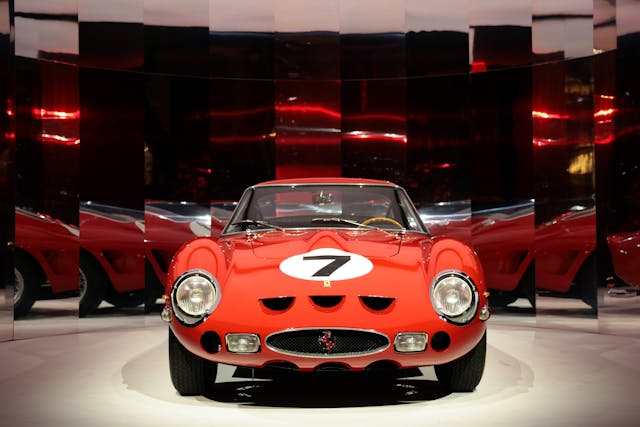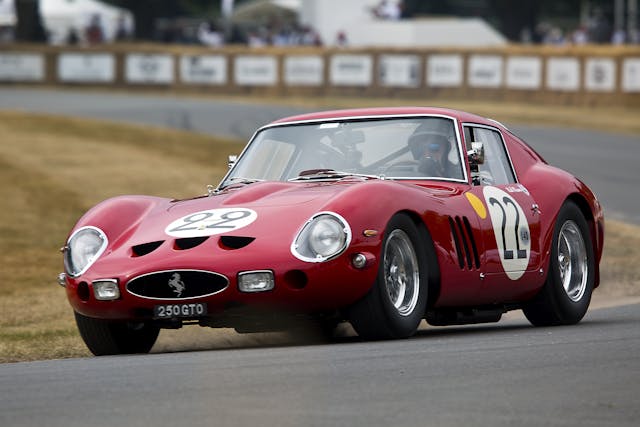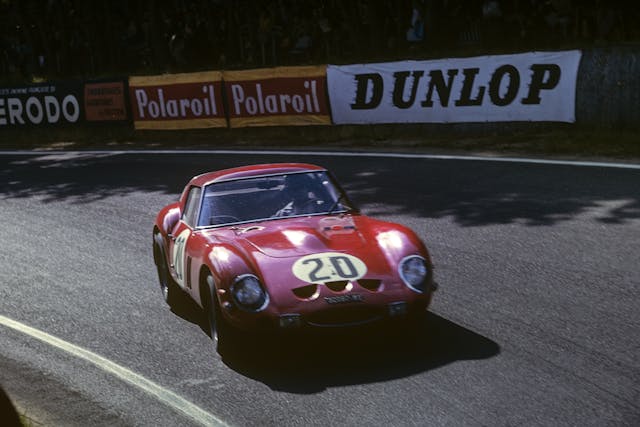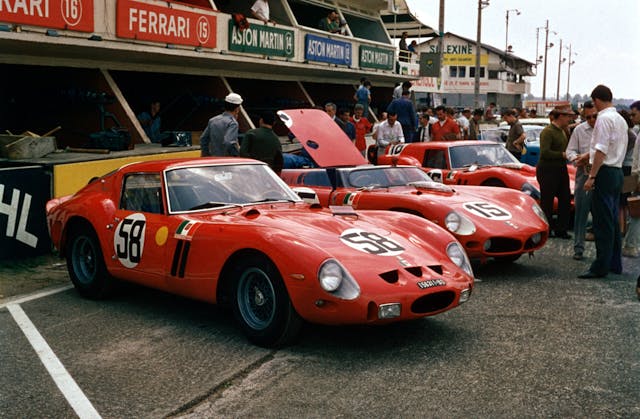Media | Articles
What sets the Ferrari 250 GTO apart?
RM Sotheby’s $51.7M sale last week of Ferrari 330 LM / 250 GTO chassis no. 3765 reminded us just how revered the all-conquering GTO is. On the rare occasion that one sells publicly, the world takes notice, and it doesn’t take a car person to recognize that it’s more than just another old vehicle.
But what does that mean, exactly, and how did the 250 GTO attain its seat at the center of the automotive pantheon? Matt Stone asked those same questions in a story for the 2012 winter special edition of Hagerty Drivers Club magazine (then called Hagerty Classic Cars magazine). He interviewed some owners, including the inimitable Alain de Cadenet, who passed away in 2022. The answers Stone found still ring true today. —EE
In any field there has always been one player, one company, one leader who stands out, be it Apple, Michael Phelps, or Ferrari. The Italian firm has built some memorable machines, but none has matched the 250 GTO, both in its dominance of the GT class and its unique appeal to collectors. We set out to uncover the root of the GTO’s amazing allure 60 years after it ruled on the track.

Ferrari’s dazzling 250 GTO enjoyed the caring touch of many gifted hands to help carry it to the pinnacle of greatness and across the threshold of automotive immortality: Enzo Ferrari, Giotto Bizzarrini, Sergio Scaglietti, and Mauro Forghieri primary among them. The GTO claims several great 250-series forefathers, of course, including the 250 Testa Rossa, Tour de France, short wheelbase Berlinetta (SWB) and California Spyder. Although no excuses need be made for any of its illustrious forebearers, the 250 GTO had it all: solid, near bulletproof mechanicals, superlative performance, exceptional and visceral beauty, and a “user friendliness” that was easily adapted to by a variety of racing drivers and which suited the car for long-distance events. It’s difficult to imagine the GTO earning a more successful competition record than a leading role in Ferrari’s domination of the FIA GT Championship in 1963 and ’64, podium fishes at Le Mans and Sebring, and countless individual sports car victories. Considering that certain diamonds (little more than very pretty rocks) and pieces of art can be worth tens of millions of dollars, then why not one of the world’s most accomplished automobiles?
District of Columbia–based private equity banker Bernard Carl has owned GTO chassis 3387 (just the second GTO constructed) since the late 1990s. The first GTO to win a major race, it won big. At the command of the three-time Le Mans-winning duo Phil Hill and Olivier Gendebien, 3387 came home first in the GT class—and second overall—in the 12 Hours of Sebring in 1962.
Marketplace
Buy and sell classics with confidence
One of the things that drew Carl so strongly to this car was its history. “It was a significant win in American motorsport history,” he says. That Hill had just won the F1 driver’s title the year before made the car extra special to Carl and thus particularly attractive. “I’d always wanted a GTO, and when this one became available it was a great choice for me.
But is his the greatest of the greatest? “It is for me, because of all that racing history and its incredible muscular beauty.” Carl adds, “It’s very mechanical, it’s very direct and you really feel like you’re driving the car, instead of the opposite, so common in today’s computer-controlled cars.
The GTO is not only the most valuable piece in my collection, it is the last thing I would sell.”

Alain de Cadenet is the consummate racer, race car builder, race team owner, writer, and popular automotive television personality, and he has fond thoughts of Ferrari’s big GT. “Ferrari really put himself on the G category map with his results at Le Mans from 1959 to 1967.” The British-born de Cadenet didn’t race a GTO until after they were no longer competitive and were simply used cars. “They didn’t cost too much at the time,” he says. “£1500 bought a decent-enough example to race and drive on the street. People used to keep quiet about racing history as that detracted from the value. Exactly the opposite today.”
Like Carl, de Cadenet believes there is much to recommend the cars. “The ubiquitous 250 engine is simple enough, but it does keep going for as long as you like, and the body shape is seriously sexy. Above all,” he adds, “these are very easy cars to put together and maintain, and they are delightful to drive on the streets and fun to race.”

But what makes them more expensive than the next closest Ferrari 250 by a factor of four? According to de Cadenet, “Way back in the mid-1970s, one or two cars were bought by impressionable folk (not poor) who were happy to pay more than perhaps they should have. Word got around, so the next guy who wants to be an owner had no choice but to pay up or go without. Over the years the major race for GTOs was not on the track but [the one that] took place just to get one.” The sale of a GTO today is a newsworthy event in the automotive world. “I don’t see that changing,” de Cadenet says.
Some years ago, de Cadenet exchanged his last GTO for a 1931 Alfa Romeo 8C. “I don’t regret it,” he says. “You have to hand it to the few folks who still have their GTOs after some 40-plus years of custodianship. What an achievement avoiding temptation.”
Another compelling reason for the GTO’s strong demand and high prices is that a 250 GTO is warmly welcomed at some of the finest motoring and motorsport events around the world. It’s all recognition that a GTO is as much a piece of art as it is emblematic of one of the golden eras in automotive and industrial history.
Charles Nearburg is a relative newcomer to Club GTO, having owned his car, chassis 3943, only about three years. “Believe me, it was a big financial leap for me to buy this car,” he says. “But it has absolutely been worth it.”
For Nearburg, there were many reasons for GTO ownership, one of which is that the car is fine art that he can see, touch, and enjoy. But he also says, “This GTO combines everything that you’d want in a car: A fabulous race history that it survived unscathed, it can be raced, shown, and driven on tours, and it’s truly wonderful to drive.

“When the car took the Enzo Ferrari Trophy at Pebble Beach [in 2011], it was just huge for our restoration team. And then to follow it up with Best of Show at the Cavallino Classic and, most recently, the Louis Vuitton Classic Concours Award was over the top.” Nearburg was originally looking for a 250 SWB but was encouraged to consider a GTO. “Once I drove one,” he says, “my whole program was refocused.”
Each of the 250 GTO owners we spoke to made it clear that the car’s investment potential was not a primary reason for their purchase. Yet their actions speak loudly. One particular Pacific Northwest collector and Forbes List regular recently paid a reputed world-record $35 million for the first right-hand-drive GTO built, painted a unique if less-than-scintillating light green. But all of these gents are successful self-made millionaires, and they are not likely to spend tens of millions of dollars in a cavalier fashion or put that money into assets likely to depreciate.
Equally important is that a high-water mark automobile such as a GTO is a tangible asset. Let’s face it, you can’t drive a stock certificate. A piece of paper, no matter how valuable, can’t make the hairs on the back of your neck stand up at 6000 rpm, nor score you an invite to Pebble Beach or the vintage races in Monaco, which a 250 GTO can and will do on any day.
Will the most accomplished GTOs continue to appreciate? Though the collector market will continue to ebb and flow, there’s little question that the 250 GTO ranks high among the world’s greatest automobiles, and that they continue to be Holy Grail–like conquests for the world’s most discerning and wealthy collectors. There appears to be nothing on the horizon to change that any time soon.
***
Check out the Hagerty Media homepage so you don’t miss a single story, or better yet, bookmark it. To get our best stories delivered right to your inbox, subscribe to our newsletters.








What has held the GTO to a high level is this.
It was the pinnacle of Ferrari GT racing. It was only built in small numbers so only a few can own.
Finally it was the last of the real hand built artistic race cars. It had an all hand formed body no computers built the engine and it was just a work of art from engine, to body and chassis.
The cars that came later were almost production line like. The 917 and GT40 were big factory efforts built in great numbers on what amounted to almost production line like work.
The GTO you can line them all up and they all are a little different in some way.
“What sets the Ferrari 250 GTO apart?”
Seems kinda like an “if you have to ask, you wouldn’t understand” question to me…
Informative article, though – thanks, Matt.